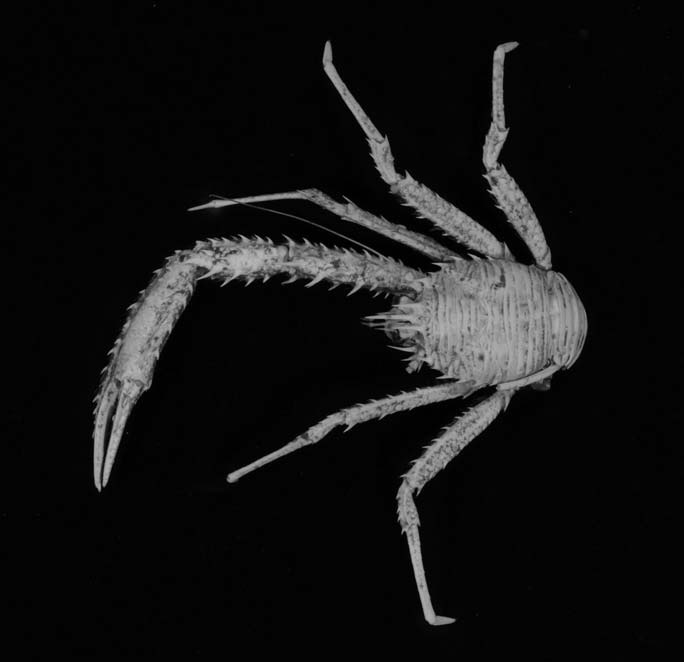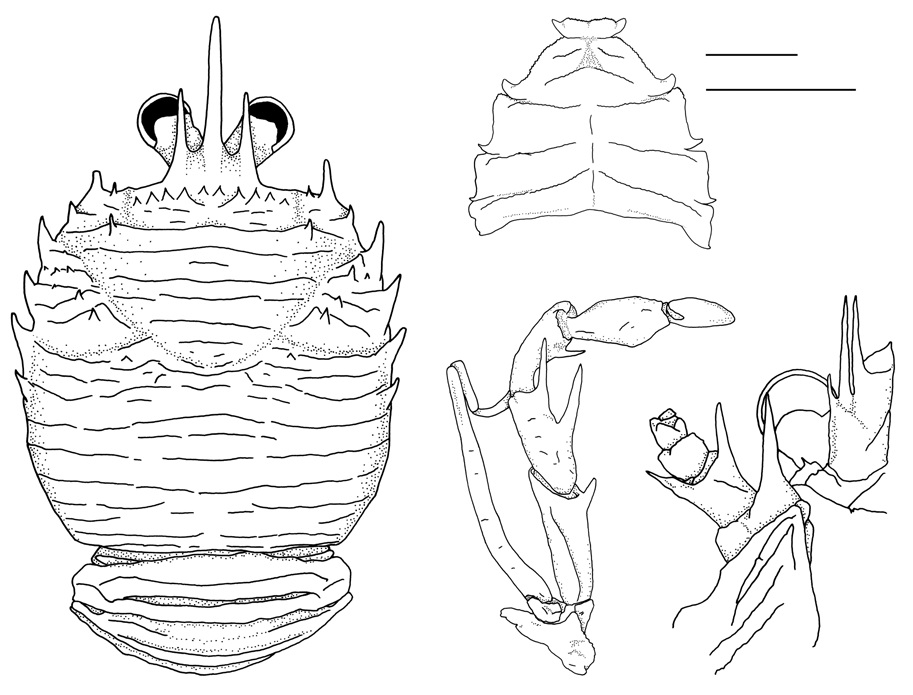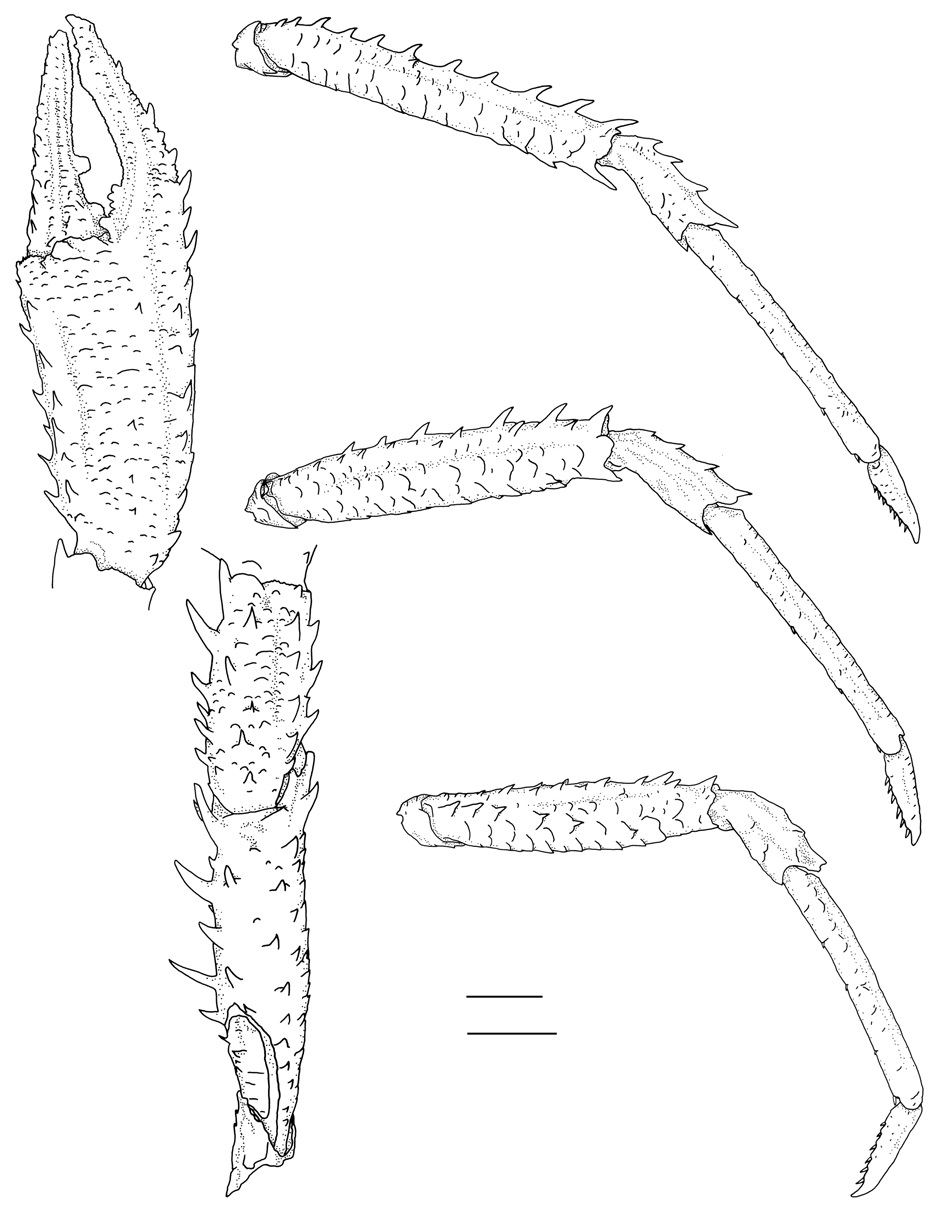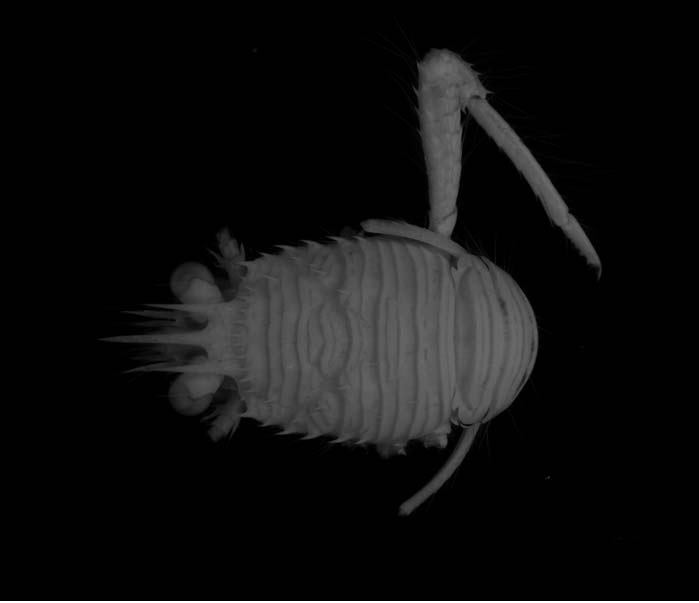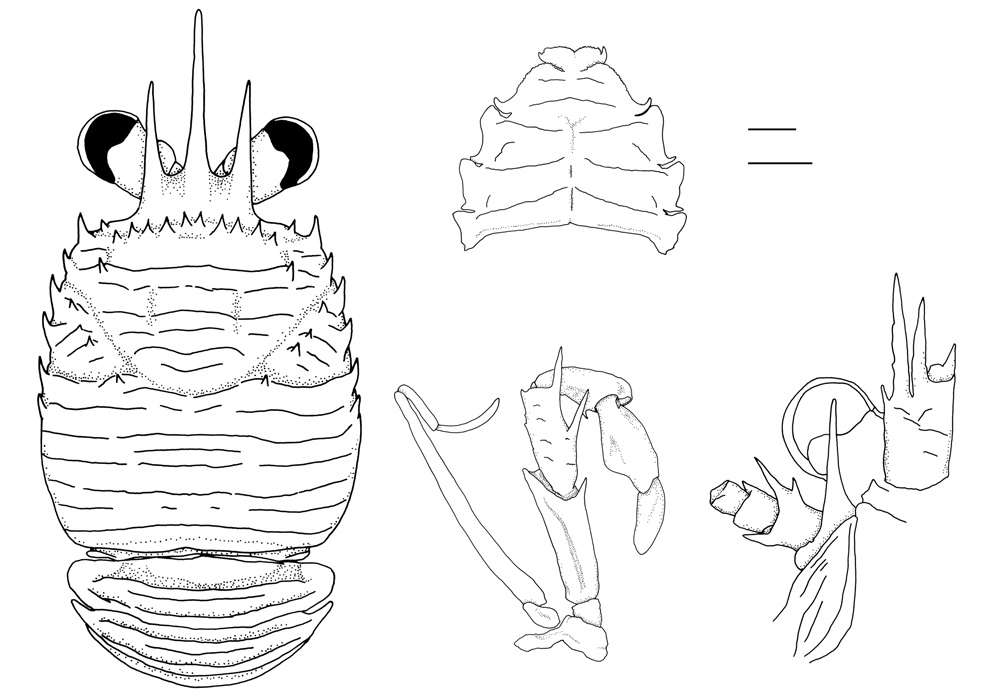



The family Munididae Ahyong, Baba, Macpherson and Poore, 2010 is the most diverse family in the galatheoids and includes 421 species in 20 genera worldwide (Macpherson and Baba, 2011). However, only 2 species of 2 genera have been reported from the Korean fauna:
The specimens examined in this study were preserved in 70% ethyl alcohol. All drawings were prepared by using camera lucida on a Nikon SMZ800 (Nikon, Tokyo, Japan). All characters were measured using an analog caliper diaMax 4112102 (Wiha, Schonach, Germany) to the nearest 0.1 mm. The terminology used follows Baba et al. (2011). The abbreviation CL refers to the carapace length measured across the middle of the carapace from the anterior border excluding rostrum to the posterior border. Higher classification follows Ahyong et al. (2011). The specimens examined in the present study are deposited in the Marine Arthropod Depository Bank of Korea (MADBK), Seoul National University.
Order Decapoda Latreille, 1802
Superfamily Galatheoidea Samouelle, 1819
1*Family Munididae Ahyong, Baba, Macpherson and Poore, 2010
1*Genus Raymunida Macpherson and Machordom, 2000
2*Raymunida formosanus Lin, Chan and Chu, 2004 (Figs. 1-3)
Material examined. 2♂♂ (CL 18.4, 19.3 mm), Korea, Jeju Island, Seogwipo-si, 10 Oct 1970.
Description. Carapace (Figs. 1, 2A), excluding rostrum, as long as broad; dorsal surface with distinct transverse striae; having 5 pairs of epigastric spines, with 1 pair of parahepatic spines and postcervical spines. Anterior branchial region having 4 to 5 spines. Frontal margin slightly oblique, having 1 small spine. Lateral margins somewhat convex, each with 6 spines: 2 anterolateral, 2 anterobranchial, 2 posterobranchial. Cervical groove distinct. Rostrum spiniform, 0.4 times as long as remaining carapace length. Supraocular spines 0.5 times as long as rostrum length, subparallel.
Pterygostomian flaps slightly rugose, unarmed.
Thoracic sternites (Fig. 2B) 0.8 times as long as broad, bearing distinct medial groove, lateral limits expanded posteriorly.
Abdominal somites 2, 3 (Figs. 1, 2A) each having 2 uninterrupted transverse ridges.
Eyes (Fig. 2A) subcylindrical, slightly expanded distally, overreaching supraocular spine.
Antennular article 1 (Fig. 2C) having 2 well-developed distal spines: 1 small distomesial, 1 well-developed distolateral; bearing 2 lateral spines: 1 short proximal, 1 prominent distal, which slightly reaching tip of distolateral spine.
Antennal article 1 (Fig. 2C) bearing 1 distomesial spine, slightly overreaching distal margin of antennal article 3. Antennal article 2 having 2 distal spines, distomesial spine
larger than distolateral spine. Antennal articles 3, 4 unarmed.
Maxilliped 3 (Fig. 2D) with ischium bearing 1 distal spine on flexor margin. Merus as long as ischium, with 2 prominent spines on flexor margin, distal spine slightly slender. Carpus having 1 spine on distal end of flexor margin. Propodus and dactylus unarmed. Exopod overreaching distal end of merus (excluding distal spine).
Pereopod 1 (Figs. 1, 3A, B) stout, squamous and spinose. Merus 3.9 times as long as broad, having irregular spines on extensor and flexor margins. Carpus 2.3 times as long as broad, bearing irregular row of spines on mesial and lateral margins, dorsal surface with some spines. Palm twice as long as broad, about 1.5 times as long as movable finger, mesial and lateral margins having irregular row of spines. Fingers having 1 distinct longitudinal ridge on dorsal and ventral sides, bearing irregular row of spines; fixed finger curved; movable finger with cutting edge having 1 large tooth on proximal third.
Pereopod 2 (Fig. 3C) slender. Ischium having 1 small spine on distoflexor margin. Merus 6.6 times as long as broad, armed with row of spines on extensor margin, flexor margin bearing row of spines on distal third. Carpus 2.2 times as long as broad, with 4 spines on extensor margin. Propodus 3.1 times longer than dactylus, 10.1 times as long as broad, flexor margin armed with 5 movable spines including distal pair: 1 distolateral, 1 distomesial (distomesial spine not illustrated). Dactylus short, curving distally, having 7 movable spines on flexor margin. Pereopod 3 (Fig. 3D) with ischium having 1 small spine on distoflexor margin; merus 4.5 times as long as broad, having row of spines on extensor margin, flexor margin bearing row of spines on distal third; carpus twice as long as broad, bearing 4 spines on extensor margin; propodus 8.8 times as long as broad, flexor margin bearing 5 movable spines including distal pair: 1 distolateral, 1 distomesial (distomesial spine not illustrated); dactylus short, curving distally, having six movable spines on flexor margin. Pereopod 4 (Fig. 3E) with ischium unarmed; merus 4.3 times as long as broad, extensor margin having row of spines; carpus
1.8 times as long as broad, extensor margin bearing 4 low spines; propodus 7.8 times as long as broad, flexor margin bearing 5 movable spines including distal pair: 1 distolateral, 1 distomesial (distomesial spine not illustrated); dactylus short, curving distally, having 6 movable spines on flexor margin.
Distribution. Taiwan, New South Wales of Australia and Korea.
Remarks.
The present specimens agreed well with the original description (Lin et al., 2004) except for the length of the distomesial spine on antennal article 1. Lin et al. (2004) mentioned that the spine reached the first antennular article. In addition, their illustration (Lin et al. 2004, fig. 1b, f) indicated that distomesial spine on antennal article 1 overreached distal margin of antennal article 4. However, in examined specimens, the spine slightly reached distal margin of antennal article 3. Such difference seems to be a morphological variation of the species.
1*Raymunida lineata Osawa, 2005 (Figs. 4-6)
Munida elegantissima: Baba, 1969: 37, figs. 3, 4.
Galathea sp. 1: Gosliner et al., 1996: 226, fig. 821.
Raymunida lineata Osawa, 2005: 92, figs. 3-6 (type locality: Izu Peninsula, Shizuoka Prefecture, 20 m); 2012: 143; Baba et al., 2008: 180.
Material examined. 1♂ (CL 6.4 mm), Korea, Jeju Island,
Seogwipo-si, Songsan-dong, 8 Mar 2002.
Description. Carapace (Figs. 4, 5A), excluding rostrum, slightly longer than broad; dorsal surface with distinct transverse striae; having 5 pairs of epigastric spines, with 1 pair of parahepatic spines and postcervical spines. Anterior branchial region having 3 spines. Frontal margin slightly oblique, having 1 small spine. Lateral margin slightly convex, each with 6 spines: 2 anterolateral, 2 anterobranchial, 2 posterobranchial. Cervical groove distinct. Rostrum spiniform, 0.5 times as long as carapace length. Supraocular spines 0.6 times as long as rostrum length, subparallel.
Pterygostomian flap slightly rugose, unarmed.
Thoracic sternites (Fig. 5B) 0.8 times as long as broad, bearing distinct medial groove, lateral limits expanded posteriorly; sternites 5, 6 having distinct oblique ridges on lateral part.
Abdominal somites 2, 3 (Figs. 4, 5A) each having 2 uninterrupted and transverse ridges.
Eyes (Fig. 5A) subcylindrial, slightly expanded distally, slightly reaching supraocular spine.
Antennular article 1 (Fig. 5C) having 2 well-developed distal spines: 1 small distomesial, 1 well-developed distolateral; bearing 2 lateral spines: 1 short proximal, 1 prominent distal (overreaching distolateral spine).
Antennal article 1 (Fig. 5C) bearing 1 distomesial spine, overreaching distal margin of antennal article 4. Antennal article 2 having 2 distal spines, distomesial spine larger than distolateral spine, mesial margin having small spine. Antennal article 3 bearing 1 small distomesial spine. Antennal article 4 unarmed.
Maxilliped 3 (Fig. 5D) with ischium bearing 1 distal spine on flexor margin. Merus as long as ischium, with 2 prominent spines on flexor margin. Carpus having 1 spine on distal end of flexor margin. Propodus and dactylus unarmed. Exopod overreaching distal end of merus (excluding distal spine).
Pereopod 1 (Fig. 6A, B) slender, squamous, setose and
spinose. Merus 4.8 times as long as broad, having irregular spines on flexor margin, extensor margin having 1 prominent spine. Carpus 2.3 times as long as broad, bearing row of irregular spines on mesial and lateral margins, mesial margin with well-developed spines, dorsal surface with some spines bearing short setae. Palm 1.6 times as long as broad, 0.6 times as long as movable finger, mesial and lateral margins having row of spines. Finger bearing row of spines; cutting edge having saw-shaped teeth.
Pereopod 2 (Fig. 6C) slender. Ischium having 1 small spine on distoflexor margin. Merus 6.3 times as long as broad, extensor margin armed with row of spines, having plumose setae; flexor margin bearing row of spines on distal half, and spine sizes increasing distally. Carpus 2.5 times as long as broad, 5 spines on extensor margin. Propodus 3 times longer than dactylus, 8.7 times as long as broad, flexor margin armed with 9 movable spines including distal pair: 1 distolateral, 1 distomesial (distomesial spine not illustrated). Dactylus short, curving distally, having 6 movable spines on flexor margin. Pereopod 3 (Fig. 6D) with ischium having 1 small spine on distoflexor margin; merus 4.5 times as long as broad, having row of spines on extensor margin, flexor margin bearing row of spines on distal third; carpus 2.5 times as long as broad, bearing 5 spines on extensor margin; propodus 8.5 times as long as broad, flexor margin bearing 7 movable spines including distal pair: 1 distolateral, 1 distomesial (distomesial spine not illustrated); dactylus short, curving distally, having 5 movable spines on flexor margin. Pereopod 4 (Fig. 6E) with ischium unarmed; merus 3.9 times as long as broad, extensor margin having row of spines; carpus 2.3 times as long as broad, extensor margin bearing 4 low spines; propodus 8.1 times as long as broad, flexor margin bearing 7 movable spines including distal pair: 1 distolateral, 1 distomesial (distomesial spine not illustrated); dactylus short, curving distally, having 6 movable spines on flexor margin.
Distribution. Indonesia, Japan and Korea.
Remarks. Osawa (2005) described that the brachial margins of
According to original description of Osawa (2005),
Key to the species of Korean munidids
1. Carpus of maxilliped 3 unarmed on distal end of flexor margin ????????????????????????????????????????????????????????????????????? 2
- Carpus of maxilliped 3 having one spine on distal end of flexor margin ??????????????????????????????????????????????????????????? 3
2. Carapace with distinct transverse striae; rostrum overreaching end of eye ??????????????????????????????????? Munida japonica
- Carapace with indistinct transverse striae; rostrum not reaching end of eye ??????????????????????? Paramunida scabra
3. Antennal article 2 unarmed on mesial margin; antennal article 3 unarmed ????????????????????? Raymunida formosanus
- Antennal article 2 having small spine on mesial margin; antennal article 3 bearing one small distomesial spine ????? ?????????????????????????????????????????????????????? Raymunida lineata
Korean name: 1*바늘이마새우붙이과 (신칭)
Korean name: 1*가시마디새우붙이속 (신칭), 2*가시마디새우붙이 (신칭)
Korean name: 1*세로줄가시마디새우붙이 (신칭)




